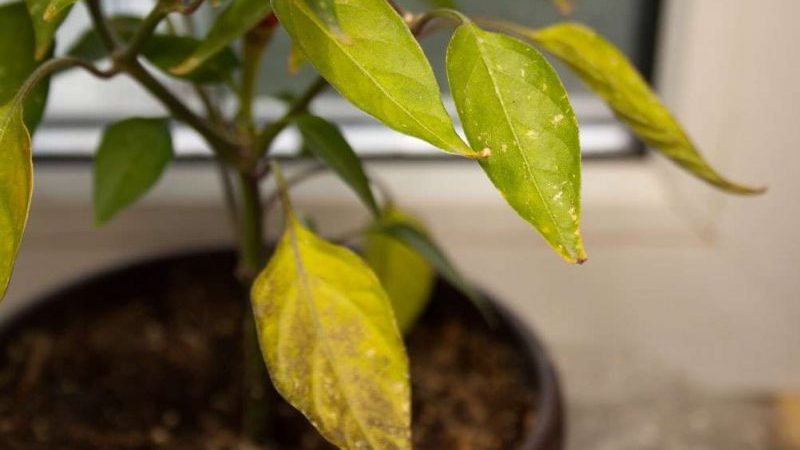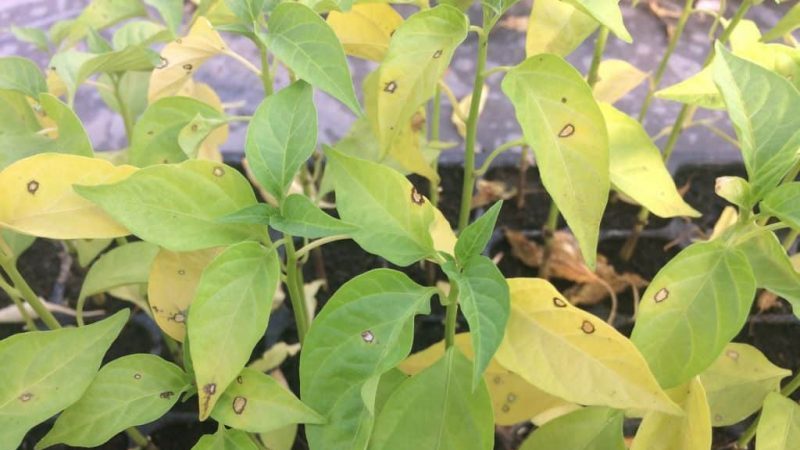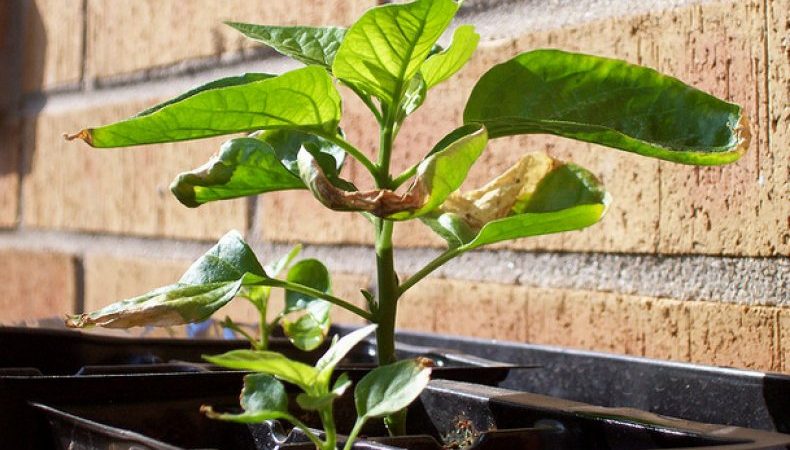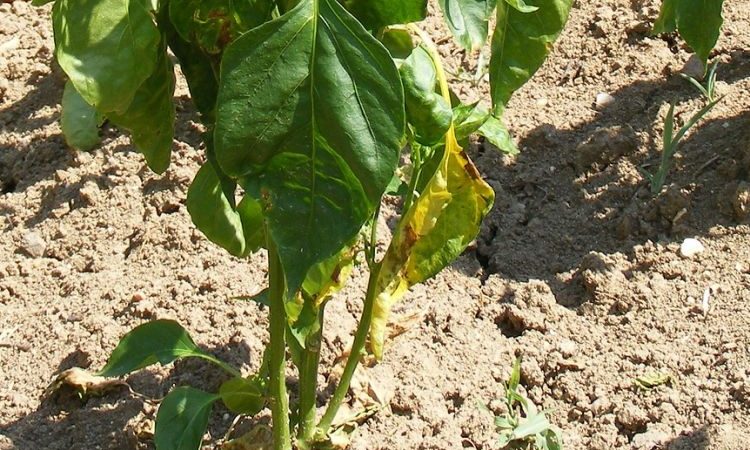Why pepper leaves turn yellow and fall: what to do to save your harvest
Pepper is a culture picky about care and environmental conditions. Yellowing and leaf fall are among the most common problems. If you do not start acting on time, you can even lose your harvest.
To avoid this trouble, study the causes of leaf shedding, methods of prevention and treatment - this is exactly what our article is about.
The content of the article
Possible causes of leaf fall
When studying the causes of the loss of leaves in pepper, attention is paid to its type and growing conditions.
Different types of pepper
Bell peppers are primarily sensitive to nutritional deficiencies, especially such as potassium, calcium, nitrogen and phosphorus. In addition, he needs an abundance of sunlight. In a region with frequent cloudy weather, it is better to grow bell peppers in a greenhouse, as additional lighting can be created there.
 For decorative peppers, you need a bright and well-ventilated place. Hot (bitter) peppers also need an abundance of sunlight.
For decorative peppers, you need a bright and well-ventilated place. Hot (bitter) peppers also need an abundance of sunlight.
Under different conditions
The development of the pepper is closely monitored at every stage of its development. When the leaves fall or turn yellow, the conditions in which the vegetable is grown are assessed.
In the greenhouse
There are a number of reasons why greenhouse peppers are losing their leaves:
- lack of light;
- the action of insect pests;
- the humidity level is too low (norm - 75%);
- the activity of bacteria and fungi;
- the air temperature in the greenhouse is below 15 ° С.
In the open field
The reasons for yellowing of pepper leaves in the open field can be as follows:
- Malnutrition of the roots due to their interlacing. When transplanting, the roots are straightened, returning to normal.
- Insufficient moisture or watering with stagnant water.
- Depleted and improperly prepared soil. The optimal ratio of humus, sand and earth in the soil is 2: 1: 1.
- In a shaded place, the metabolism of plants decreases, which also leads to leaf fall.
- Sudden temperature changes harm the seedlings - pepper is thermophilic.
Why leaves can fall

The reasons leading to yellowing and dropping of pepper leaves are divided into several categories: environmental factors, agricultural errors, the influence of insects and diseases.
External factors
External factors include:
- Temperature conditions. Pepper loves warmth and does not like cold and drafts, as he himself is from Central America. The optimal temperature balance is + 24-27 ° С during the day and + 14-17 ° С at night.
- Lighting. Pepper loves sunny places for the same reason as warmth. And with a lack of light, the seedling will first stretch out quickly and then shed the leaves. Optimum provision of at least 12 hours of ambient light. The abundance of direct sunlight harms the bushes.
- Airing mode. Peppers in the greenhouse need aeration. In the warm season, the room is ventilated twice: in the morning and in the evening. Cold air accumulated during the night and excessively hot daytime air are released. In spring, while it is not warm enough outside, the room is not ventilated.
Errors in agricultural technology
Flaws in the care of the plant can cause yellowing and falling leaves. Let's consider them in more detail.
Waterlogged soil
Over-watering causes the roots to rot. If the soil is light, water only as needed. If the soil is dense, when watering it will store moisture for several days, while the root will experience oxygen starvation, which will also lead to rotting. In this case, dry irrigation is used.
Reference! Dry watering is a technique used in agricultural technology to reduce moisture evaporation. If a dense crust forms on the ground after precipitation, the top layer of the soil is loosened to a depth of 4-5 cm.
Insufficient soil moisture
Pepper consists of 93% water, while it has a small root system, so it needs frequent and abundant watering. The land should be saturated with moisture at a depth of 16-20 cm.The plant signals a lack of water in a certain way: first, the leaves turn yellow and fall, then ovaries and flowers, after the stem itself becomes soft.
Lack of nutrients

Every plant reacts in a certain way to nutritional deficiencies, and peppers are no exception. If the bush looks emaciated, although all other conditions are met, it is given organic or mineral feeding.
How is the lack of nutrients manifested:
- Lack of nitrogen in the soil causes bending of the stems and yellowing of the leaves.
- Lack of potassium will manifest itself only during the fruiting period. Directly at this time, feeding is not carried out, therefore, throughout the entire growth of the plant, potassium intake is taken into account and regulated.
- It is possible to satisfy the need for iron already at the stage of planting seedlings. If the soil on the site is calcareous or clayey, it is initially enriched with complex fertilizers. Prolonged iron deficiency causes leaf discoloration.
- If the growth of the root and stem of the pepper is slowed down, the leaves have acquired an awl-like shape and an uncharacteristic gray-yellow color, this indicates a lack of calcium or an overdose of potassium or nitrogen.
Toxins
Failure to comply with crop rotation and growing peppers in the place where other nightshades were planted before, soil depletion or toxin poisoning may occur. Harmful substances accumulate in the ground as a result of the life of plants.
Interlacing roots
Interlaced roots that are unable to absorb nutrients can interfere with normal nutrition. This situation arises as a result of active root growth and can lead to their death.
Scarcity of soil
The soil plays a fundamental role in the formation of a healthy plant. Nutrition, flowering and development of ovaries depend on it. For nutritional value, the soil is enriched with vermicompost.
Dense plantings
Pepper seedlings are very sensitive to close proximity. When planted close, vegetables compete with each other for nutrients and light, causing foliage to fall off.
Pests and diseases

Often, the activity of pests, such as aphids and spider mites, becomes the cause of twisting, yellowing and falling foliage in peppers. They use plant sap for nutrition. The most favorable conditions for these pests are low humidity and high temperatures.
Important! Already at the first sign, the plant is carefully examined for the presence of harmful insects. Aphids are visible with the naked eye, a tick is identified by the presence of a white spider web on the leaves.
Falling foliage can be a signal that the plant is affected by a disease. Late blight causes thickening of the affected parts and dark spots on them. Bright yellow coloration and incessant withering talk about fusarium.
In some cases, leaf fall may be caused by the leaf's central vein growing faster than itself. This situation is considered normal and does not require intervention.
What to do
There is a set of measures to save the pepper. It is an integrated approach, which includes correcting mistakes and competent feeding, that will ensure the normal development of the vegetable.
How to feed
The nutritional deficiency in pepper is eliminated in several stages. First, they determine which substances are missing:
- With a lack of potassium and nitrogen, the leaves turn yellow and fall off. Due to the lack of nitrogen, the leaves of the plant turn pale.
- With a deficiency of iron and manganese, the leaves turn yellow. Potassium deficiency causes the leaves to shrink.
After that, top dressing is carried out. The introduction of a complex of mineral fertilizers will stop the leaf fall of the pepper. There is a special feeding method: only the leaves are sprayed with the nutrient composition.
What errors to fix

The temperature of the water for irrigation should be warmed up by the sun up to 24 ° С... If you water the pepper with cold water at least once, it will begin to shed the leaves. Water it in the morning and evening until the ground cools.
They normalize the flow of light. It is recommended to plant peppers in an unshaded area. However, light-loving varieties in the midday heat, they are protected from excessive sunlight. If the weather in the region where the plant is grown is often rainy and cloudy, pepper is planted only in a greenhouse.
Peppers are examined for spider mites and aphids. Regular inspections will help contain the pest population. If their obvious negative effect is noticeable, they acquire insecticidal preparations and act strictly according to the instructions.
Peppers do not grow in acidic soil. It is necessary to provide them with a neutral soil.
The peppers are adapted before transplanting. Within two weeks before transplanting, the seedlings are exposed on the balcony in the daytime, and returned back at night.
Why do the leaves of pepper seedlings turn yellow and fall
Often, the leaves fall off the seedlings. To preserve it, they act quickly: determine the cause and take appropriate measures.
The reasons
The reasons why in young peppers the leaves begin to turn yellow and fall off are similar to those in adult plants:
- improperly selected lighting;
- a sharp change in temperature;
- malnutrition;
- activity of pests and diseases;
- improper watering.
If only the lower leaves of the seedlings acquire a yellow color, there is no cause for concern - natural dying off occurs. If both the lower and upper leaves begin to turn yellow, the plant is urgently saved.
Pepper seedlings also have a negative effect:
- too acidic soil;
- deep planting of plants (peppers must be planted to a depth of 1 to 2 cm).
What to do
How to fix the situation:
- The main reason for yellow falling leaves in pepper seedlings is improper lighting. The plant is given a lot of diffused light during the day and backlighting at night. For night light, fluorescent lamps with a power of 40-80 W are used.
- The most suitable temperature for growing seedlings is from + 20 ° С to + 30 ° С during the day and not lower than + 15 ° С at night.
- The nutritional deficiency is eliminated by the introduction of complex mineral fertilizers.
- Leaves turn yellow and fall off due to diseases, some of which are caused by pests. To get rid of harmful insects, special means are used: from aphids - tobacco dust and ash, from spider mites - "Fufanon", "Aktellik", "Karbofos". In the treatment of late blight, the Zaslon sprayer is used. With fusarium, it is impossible to save the infected parts of the plants, so they get rid of them.
- Sprinkle pepper seedlings often and abundantly, using dry watering if necessary. Check the degree of moisture in the earth at depth.
- If the leaves of the seedlings begin to turn yellow, the soil is enriched with fertilizers that contain potassium, magnesium, phosphorus. If yellow Colour the upper leaves were also acquired, zinc, iron and boron are added to the top dressing.
Preventive measures

To prevent yellowing and fall of foliage in seedlings, a number of preventive measures are taken:
- watering with warm water;
- hardening of seedlings before planting;
- selection of a well-lit area for planting;
- regular fertilization;
- maintaining the optimal temperature in the greenhouse and observing the ventilation regime
Conclusion
To cope with yellowing and falling foliage, preventive measures are followed. Using warm water for irrigation, feeding, cultivation at a temperature of + 20 ... + 30 ° C and hardening of seedlings will prevent the loss of leaves from the plant.
A thorough examination of the plant, the identification of the causes that caused the negative effect, and their elimination will help to save the already yellowed leaves.